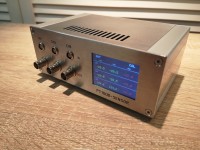Self-Calibrating 3-Channel Temperature Measuring Device with PT1000 Sensors

A compact temperature measuring device with three channels is presented. In order to achieve high accuracy, PT1000 sensors were chosen in combination with a calibration procedure, which results in a combined standard uncertainty of 0.3 degrees Celsius. The measurement results are available as analog values at the BNC output and as numerical values with min/max capturing on the display with touchscreen functionality.
However, the PT100 sensors are replaced by PT1000 types (three-wire connection) to achieve high accuracy over the whole measurement range of interest.
The measuring device was primarily designed for optimizing temperature controls for precision voltage sources, but should also be suitable for versatile use.
The following aspects were taken into account in the design and operating concept of the measuring device:
● Simultaneous recording of the temperature from three PT1000 sensors.
● Temperature measurement in the dynamic range from -25 to +125 deg. Celsius.
● Provision of the measured variables as analog values via BNC sockets.
● Display of the minimum, maximum and actual values on a coloured display.
● Individual reset of min and max values.
● Easy calibration of the three measuring chains.
● Storage and automatic retrieval of calibration parameters.
● Standard measurement uncertainty at the analog output no more than 0.5 deg. Celsius despite
the use of uncalibrated standard PT1000 sensors of tolerance class F 0.15 (A).
● Operation of the device via battery or external power supply.
● Monitoring the battery status.
● Compact design and easy handling via touchscreen functions.
The technical description deals in detail with all relevant aspects of the electrical design and mechanical construction (see PT1000_Temperature Sensor_V0en and corresponding Appendices).
For a measurement system, it is also essential to estimate the measurement uncertainty in order to obtain trustworthy measurement results.
The documentation is supplemented by commissioning experiences, in particular the elimination of an EMI problem with the processor.
Further information can be taken from the documentation, see table of contents
1 Objective
2 Make-Up of the Measuring System
2.1 Analog Measurement Channels
2.2 Digital Part
2.3 2.4 Inch Colour Display
2.4 Power Supply
3 Construction of the Measuring Device
3.1 PCB Design
3.2 Mechanical Design
4 Fabrication of the Measuring Device
4.1 PCB Assembly
4.2 Assembly of the Housing
5 Operating Concept
5.1 Measurement Mode (MESS)
5.2 Calibration Mode (CAL)
5.3 Battery Monitoring (BAT)
6 Commissioning Experiences
7 Estimation of Measurement Uncertainty
7.1 Transfer Characteristics of PT1000-Sensors
7.2 Measurement Uncertainty Budget
7.3 Systematic Errors
The software was written in C++ using Visual Studio 2022 and the Arduino IDE Visual Micro.
The source code is attached to this project.
The operation of the measuring device is shown in a video on youtube
https://youtu.be/xFn7QxV6I5M



Discussie (0 opmerking(en))